
Tobacco and Medicine Menu: 1 2 3 4 5 6 7 8 9 10 11 12 13 14 15 Next>>
Tobacco and Medicine During the Golden Age of Piracy, Page 1
“Seafaring-men therefore, and Persons trading abroad, cannot Export a more useful Commodity than this TOBACCO.” (Of the Use of Tobacco, Coffee, Chocolate, Tea and Drams, 1722, p. 5)
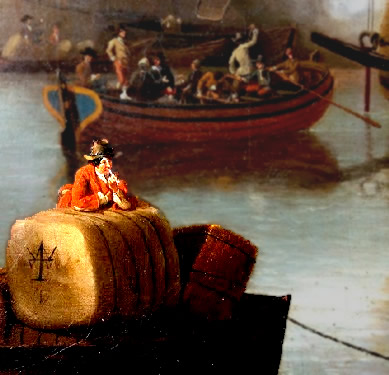
Artist: Samuel Scott
Sailor on the Docks Smoking, Detail From "Shipping at Anchor in the
Thames
Estuary,
near Wapping," (mid 18th century)
Of all the vices made available to man courtesy of the Age of Exploration, none has such close ties to the sailor as tobacco. It's history began with Columbus's first voyage to the Americas in 1492 and its dissemination throughout the 'Old World' of Europe came courtesy of his sailors and those who followed them. The first European smoker was sent by Columbus to explore the island of Cuba where he and a friend found the natives inhaling the smoke of the tobacco plant. He picked up the habit there and was the first to bring the custom back with him and share this new found pleasure. Tobacco became a staple of the sea-faring trade and was so accepted and ubiquitous that it often rates little more than casual mention in many sailors' accounts during the golden age of piracy.
This article begins with an exploration of the history of tobacco up until the golden age of piracy, focusing primarily on its ties to sailors and the sea. It looks into the cultivation of the plant and the tools associated with tobacco using during this period. From there it looks at the various public perceptions of tobacco in the seventeenth and eighteenth centuries. This is followed by an examination of the references to tobacco found in period sailor's and pirates accounts. Because tobacco was plant and plants were the source of most of the medicines in use at this time, it finishes with a discussion of the health effects assigned to the plant, debates over its effectiveness as a drug and how it was used in medicine.
A Brief History of Tobacco Through the Golden Age of Piracy
“Tobacco is an extraordinary historical phenomenon. Until the date of the first encounter between Amerindians and Europeans at the very end of the fifteenth century, no society outside of North and South America had any idea of its existence.” (Jordan Goodman, “Webs of Dependence: Towards a Political History of Tobacco,” Ashes to Ashes: The History of Smoking and Health, 1998, p. 5)

Artist: Theodore de Bry
A Fanciful Image of Natives Bringing Columbus Gifts (1594)
Tobacco first came to the attention of Europe through the offices of Columbus's first exploratory voyage. Italian writer Count Eugenio Courti says that when the Taino natives first encountered Columbus on Guanahani, Bahamas on October 12th, "they gave them of their best; strange fruits, wooden javelins, balls of cotton, were among the choicest gifts, as well as the dried leaves of some plant which had a remarkable odour."1 He goes on to suggest that Columbus accepted most of these gifts with bemusement, but "flung away the dried leaves as worthless."2 These leaves are not mentioned in the English translations3. However, when the crew encountered an Indian in a canoe three days later, Columbus gives the following description: "He had a little of their bread, about the size of a fist, a calabash of water, a piece of brown earth powdered and then kneaded, and some dried leaves, which must be a thing highly valued by them for they bartered with it at San Salvador [Bahamas]."4 These dried leaves are almost certainly tobacco.
The plant is more definitely identified by two of Columbus's men - Rodrigo de Jerez and Luis de Torres - whom he sent to explore the island of Cuba on November 2nd, 1492. Reporting back to Columbus four days later, they mentioned that the men and women in a small village on the island went around "with a brand
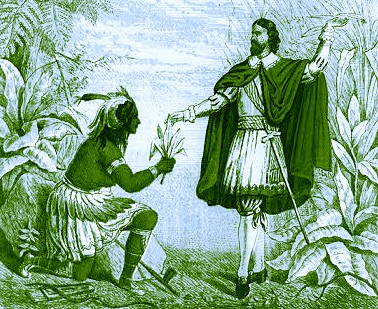
A Fanciful Image of Rodrigo de Jerez Receiving Tobacco Leaves From an
Amerindian,
From
A. Levy's "Pride of Columbus" Tobacco Label (1866)
in their hand, [and] herbs to smoke as they are accustomed to do."5
Writing in 1527, Bishop Bartolome de las Casas expands greatly upon the account of Jerez and Torres. He says that
the men with a brand in their hands and certain herbs to take their smoke, which are dry herbs placed in a certain leaf, also dry like the paper muskets which boys make at Easter time [blow pipes]. Having lighted one end of it, they suck at the other end or draw in with the breath that smoke with which they make themselves drowsy and as if drunk, and in that way, they say, cease to feel fatigue. These muskets, or whatever we call them, they call tabacos.6
The Dominican friar was likely embellishing the account using his own experiences. He moved to Hispaniola in 1502 and spent decades in New America, much of it advocating for the natives against the rule of the Spanish. He said of smoking, "I knew Spaniards in this island of Espanola who were accustomed to take them [tobaccos], who, when they wore rebuked for it as a vice, replied they could not give it up. I do not know what pleasant taste or profit they found in them."7
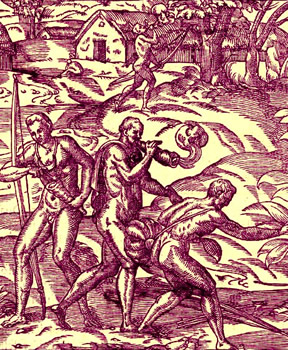
Artist: André Thevet
A Fanciful Illustration of Native Americans Smoking
Pourtrait de l'herbe Petu[m] ou Angoulmoisine, From
La cosmographie uniuerselle, Tome seconde (1575)
Criticism of tobacco use was not uncommon among the early explorers. Gonzalo Fernández de Oviedo y Valdés (Or 'Oviedo' as he is commonly known today), first visited New America in 1514. He reported,
The Indians inhabiting this island [Hispaniola aka. Haiti] have, among their other evil customs, one which is very pernicious, —namely, that of smoking, called by them tobacco, for the purpose of producing insensibility. This they effect by means of the smoke of a certain herb, which so far as I can learn is of a poisonous quality, though not poisonous in its appearance. ...I cannot comprehend what pleasure is derived from this practice, unless it be such as results from drinking [the tobacco smoke] to excess.8
Note that tobacco smoking was sometimes referred to as "drinking", particularly during the 16th and early 17th centuries.
Other than these sources, little was said about tobacco until the latter half of the 16th century. William Andrew Chatto points out, “Except from the account of Oviedo, and a brief notice by one or two other writers, neither the name nor the use of tobacco appears to have been known in Europe till about 1560"9. It is around this time that tobacco formally made its way from the old world to the new via the Spanish and Portuguese explorers. There are essentially two explanations of how tobacco entered European history: one formal, the other informal. Since the role of the sailor is predominant in each, we will look at both, beginning with the formal history.
1,2 Count Eugenio Courti, A History of Smoking, Translated by Paul England, 1932, p. 37; 3 For examples, see Journal of the First Voyage of Columbus, Document AJ-062, Wisconsin Historical Society Digitial Library and Archives, 2003, pp. 110-6 & Steven Kreis, Journal of the First Voyage of Christopher Columbus, Document No. AJ-061, Wisconsin Historical Society, p. 117; 5,6,7 Journal of the First Voyage of Columbus, Document AJ-062, p. 141; 8 G. F. Oviedo, Historia General de las lndias, Libra V., Capit. 2., Edit. 1535, Translated by William Andrew Chatto (as Joseph Fume), A Paper: - Of Tobacco, 1839, pp. 5-6; 9 Chatto/Fume, p. 15
A Brief History of Tobacco's Entry Into the Old World - Formal History
The tobacco plant was initially brought into Europe to be grown in personal gardens in Europe; this was either

Artists: Pedro Reinel, Jorge Reinel, Lopo Homem (mapmakers), and António de Holanda
Portuguese Map of Brazil, Their Source for Imported Tobacco (1519)
because of its interesting appearance or because of its value as a medicinal. Since the Spanish and Portuguese were the first explorers of the new world, it was they who brought it home. Seeds imported from Florida may have been grown as early 1558 in the royal gardens of Lisbon, suggested to have been planted there by scholar and philosopher Damião de Góis.1 Flemish botanist Charles d' Ecluse (Carolo Clusius) visited Spain in 1560 and Portugal in 1564-5 and reported that he saw tobacco flowering in the winter in garden in Portugal.2
It quickly made its way to Italy through the work of Portuguese bishop and papal diplomat Prospero Santacroce. He encountered the plant while stationed in Lisbon, Portugal brought it to Italy in 1561.3
While Spain likely had the first opportunity to bring tobacco plants back to the old world, anthropologist and historical geographer Berthold Laufer says that the timing of Spain's role in importing tobacco to the old world is unknown. "The date of its first introduction into Spain is not exactly ascertained, various names and dates are suggested, but these accounts are not well authenticated; the exact date, moreover, is of no consequence, as Spain contributed nothing to the diffusion of the plant over Europe."4 He further points out that this was because "the Spaniards were exclusive and never took the trouble of propagating tobacco or any other American plant to any country of Europe."5
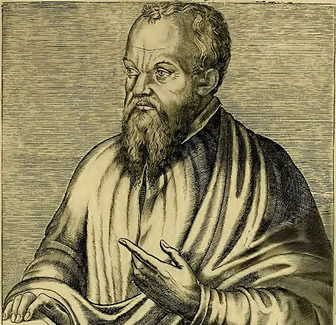
André Thevet (1584)
Two different people have been associated with bringing tobacco into France.
The first is Franciscan priest and explorer André Thevet, who spent November 1555 - January 1556 in Brazil. He published a book about his time there in 1558 called Les Singularitez de Ia France antarctique, autrement nommee Amerique: et de plusieurs terres et isles decouvertes de nostre temps. He describes the plant (calling it petun), "which they [the natives of Brazil] ordinarily carry with them, because they consider it to be marvelous, [it] is profitable to many different things."6 He explains how the natives smoked the tobacco, noting that they wrap the dried tobacco in palm leaves, "rolling it about the length of a candle, then set fire to one end, and receive the smoke from it by the nose and mouth."7 Thevet mentions that he tried smoking it, but fainted ('I fell into a syncope') as a result.8
The second person identified as bringing tobacco into France was the French ambassador to Portugal in 1559-61, Jean Nicot. Physician and botanist Nicholás Monardes says that Nicot was given tobacco seeds by Portuguese King Sebastian I's head jailor while touring their prison. "The same Maister Nicot, having caused the said hearb to be set in his Garden, where it grewe and multiplied marvellously"9.
Learning of the purported healing properties of the plant in 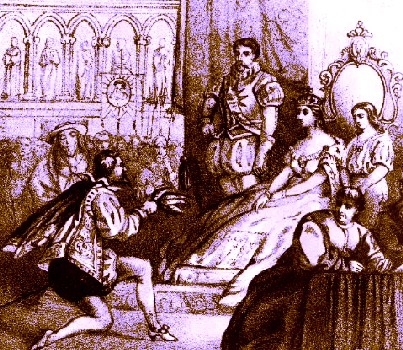
A Fanciful Image of Jean Nicot Presenting Tobacco Leaves to Queen Catherine
de Medicis, From a Levi Brothers Tobacco Package (1868)
cancerous swellings (called Noli mi tangere), Ambassador Nicot had a "sicke young man to bee brought before him, and causing the saide hearb to be continued to the sore eight or ten daies, this saide Noli me tangere, was utterly extinguished and healed"10. According to Charles Estienne and Jean Liebault, Nicot then sent a sample of the tobacco plant with a description of its uses "to a certeine Phistion of the king of Pourtugall [possibly Fernando Mendez] one of the greatest to examine the further working and effect of the said Nicotaine" who, upon examining the patient agreed with Nicot's estimation of the plant.11
When Nicot returned to France from Portugal, he presented French Queen Catherine de Medici with some tobacco plants. She found the snuff of the plant to be useful in treating here frequent headaches. As a result, she named the plant "in honour of the original importer; thus Nicotiana became its recognised name, a term still preserved to us in Nicotine, the scientific name for the essential oil the tobacco-plant contains."12
Thevet did not take Nicot's claim well. In the first volume of his 1575 book La Cosmographie universelle (1575) he complained that the herb had been named Angoulmoidine by him, "the first of all France who bore the seed, coming from these countries: not without coming to my mind, however, that those who have never before in these said distant lands [Nicot], dared to baptize it by [another] name [Nicotiana], and so wished to deprive me of the honor which is due to me."13 Historian Laufer suggests that the two men brought different types of tobacco to France: "the species introduced by Thevet from Brazil can but have been Nicotiana tabacum (of some Brazilian variety), and what Nicot introduced must have been N. rustica, which flourished in Florida, where N. tabacum was at that time unknown."14 Because of this, he feels that both men deserve credit for introducing the plant to France, but since Nicotiana tabacum is more popular today, Thevet may deserve more credit than Nicot. Whether or not this is true, it seems like an odd thing for a Franciscan priest to be upset about.
Although Spain's possible early planting of tobacco is unknown a later date for presentation of tobacco to the Spanish King is presented as likely. In 1570, King Phillip II of Spain sent his court physician Franciso Hernández de Toledo to the New World to document the plants that were found there and look into their potential medical uses.
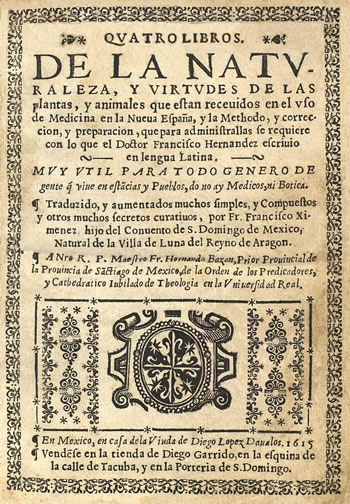
Quatro Libros de la Naturaleza y Virtudes de las Plantas y Animales,
By Francisco Hernandez (1615)
Hernández spent seven years examining plants, interviewing the native people about their uses and having images drawn. Upon his return to Spain, Hernández provided the King with sixteen illustrated volumes containing over three thousand different plants and is believed to have brought either a tobacco plant or seeds back from Mexico for the King's inspection in 1577.15
Like Spain, when and how tobacco made its way to England isn't entirely clear. Notice of the plant was first given via explorer Sir John Hawkins' second voyage to Venezuela, Columbia and Florida, as documented by John Sparke the Younger's account of the voyage in 1565. "The Floridians when they travell have a kind of herbe dryed, which with a cane, and an earthen cup in the end [clearly a pipe], with fire, and the dried herbs put together do sucke thro the cane the smoke thereof"16. Sparke also notes that the French settlers in Florida likewise smoked tobacco. However, he stops short of suggesting that the English did likewise and it is not clear that Hawkins or his men brought the plant or its seeds back to England.
In support of Hawkins being the first to bring tobacco to England, Edmund Howes, writing in John Stow's Annales or Generall Chronicale of England in 1631, asserts "Tobacco was first brought and made known in England by Sir John Hawkins, about the yeare 1565, but not used by Englishmen in many yeeres after".17 Poet John Taylor, an avowed fan of tobacco, basically copies this line, adding that although tobacco had arrived it "was first brought into use by Sir Walter Raleigh many years after."18
Raleigh was often credited with bringing tobacco to England, although if Hawkins wasn't
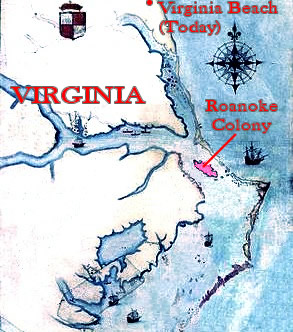
Cartographer: John White
Map of Roanoke Colony Location in Virginia (c. 1585)
the way the plant made it to mother England, evidence suggests neither was Raleigh. Still, Raleigh may have been instrumental in getting the plant back to England. He was granted a charter by Queen Elizabeth I in 1584 which gave him seven years to establish a settlement in the new world. Raleigh didn't actually go to North America to create the settlement, he sent Sir Richard Grenville to do so in 1585. Accompanying Grenville was mathematician Thomas Hariot who was to observe and report on the new Virginia colony's progress as well as anything of scientific interest. The colony ended up falling apart and the survivors had to be rescued by Sir Francis Drake, who touched at Roanoke Island in June of 1586.
Upon returning to England, Hariot wrote an account of the Virginia colony where he explained, "We ourselves during the time we were there used to suck it [tobacco] after their maner [using pipes], as also since our returne, & have found manie rare and wonderful experiments of the vertues thereof; of which the relation woulde require a volume by it selfe"19. The colonists had been in regular contact with the local Algonquian natives, relying upon them when their food supplies were lost. This acquaintance resulting in their adopting "the habit of smoking, and become so attached to it that they continued the practice after their return to England."20
Having enjoyed the plant while in America, the colonists brought some back with them. They must have given some to Raleigh, for he became addicted to it. "The herb's recreational use was popularized by a group at the royal court consisting of Sir Walter Raleigh, the Earl of Northumberland, and their advisor on mathematics and navigation, Thomas Harriot."21
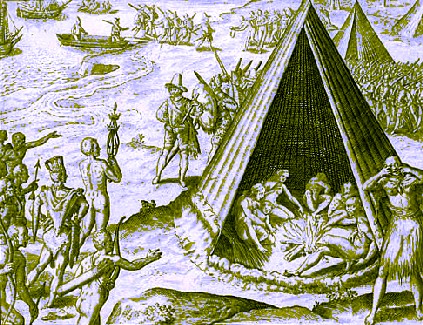
Artist: Theodore de Bry
A Fanciful Image of Drake's Landing in New Albion in 1579 (1590)
The rescue of the Roanoke Colony's members was not Sir Francis Drake's first encounter with tobacco. He had sailed with Hawkins on his three voyages to the new world in 1563, 1564 and 1568. He sailed to the West Indies on trading voyages in 1570 and 1571 and then again as an independent explorer in 1572-3. Although he likely encountered tobacco on some or even all of these voyages, nothing is known for certain.
Tobacco first appears in the chronicle of Drake's most famous journey, the voyage round the world during 1577-80, written by sailor Francis Fletcher and edited by Raleigh's nephew. On this voyage, Drake encountered natives in California at a place he called New Albion (near modern San Francisco). Fletcher's June 18t, 1579 entry explains that one of the tribe's men brought them a headdress of feathers along with "a little basket made of rushes, and filled with an hearbe which they called Tabah. Both which being tied to a short rodde, he cast into our boat."22 They were presented with more tobacco the next day.23
Laufer argues
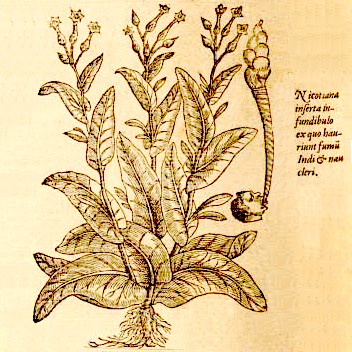
Tobacco Plant and Smoker from Matthias de l'Obel & Pierre Pena,
Stirpium adversaria nova, p. 251 (1570-1)
(in somewhat overwrought prose) that tobacco was first brought to England via Drake's first independent voyage made in 1572 and 1573. Laufer claims that Flemish physician and botanist Matthias de l'Obel's book "affirms tobacco culture in England (prior to 1576) and describes pipe-smoking on the part of sailors who returned from America."24
l'Obel's book was first published in 1570-1 and (based on my rudimentary Latin interpreting skills) mentions that the plant was brought from the West Indies by Portugal, France, Belgium, and England a few years previous to its publishing.25 l'Obel also says the plants could be found growing in France, the Netherlands and England, although it grew better in warmer regions.26 He includes an image of the plant along with the inscription, "Tobacco [Nicotiana] inserted into a funnel, from which the Indians and ship's captains absorb the fumes."27 From this caption, Laufer says "that there is no escape from the conclusion, that tobacco was brought to England again in 1573 by Sir Francis Drake (whether by himself personally or by a sailor or member of his expedition remains immaterial)"28. Although he seems quite sure of himself, the accuracy of this statement is impossible to verify.
Thus endeth the formal history of tobacco's entry into Europe. Although the sailor influence is evident here, the informal history is considerably more interesting
1 Berthold Laufer, "The Introduction of Tobacco into Europe", Field Museum of Natural History, Department of Anthropology, Chicago, Leaflet Number 19, 1924, pp. 49; 2,3,4 Laufer, p. 55; 5 Laufer, p. 5-6; 6 "...laquelle ils portent ordinairement avec eux, pource qu'ils l'estiment merveilieusemét profitable à pluiieurs choies.", André Thevet, Les Singularitez de Ia France antarctique...", 1558, p. 60; 7 "Ils l'enveloppent, estant seiche, quelque qualité de ceste herbe en une fueille de palmier, qui est fort grande, & la rollent come de la longueur d'une chandelle, puis mettent le feu par un bout, & en reçoivent la fumée par le nez, & par la bouche.", André Thevet, Les Singularitez de Ia France antarctique...", 1558, p. 60; 8 Thevet, p. 61; 9,10 Charles Estienne and Jean Liebault, Joyfull Newes out of the newfound world, John Frampton, translator, 1580, f.42v; 11 Estienne and Liebault, f.42v-43r; 12 Frederick William Fairhholt, Tobacco Its History and Associations, 1862, p. 45-6; "Or ce que i'ay veu de fingulier en ceste isle, & qui mérite d'estre escrit, c'est une herbe toute semblable en grandeur, grosseur, & sueillage, à celle qui se nomme en langue des Sauvages de l'Antarctique Petum, à la quelle i'ay donné le nom d'Angoulmoidine, comme edtat le premier de toute la France qui en a porté la graine,venant de ces pais là: non sans m'estonner toutefois de ceux qui n'ayans iamais mis le pied en cesdits pais lointains, l'ont ose baptiser de leur nom, voulas par ce moyen me priver de l'honeur qui m'en est deu.", André Thevet, La Cosmographie universelle, Volume 1, 1575, f.142r; 14 Laufer, p. 51-2; 15 Fairhholt, p. 46; 16 John Sparke, "The voyage made by the worshipful M. lohn Haukins, Esquire, now Knight", The Hawkins Voyages, Clements Markham, ed, 1878, p. 57; 17 Edmund Howes, Annales, or a Generall chronicle of England, begun by John Stow, continued and augmented unto the end of this present yeere, 1631, 1631-2, p. 1038; 18 John Taylor, The Old, Old, Very Old Man, 1635, p. 27; 19 Thomas Hariot, A briefe and true report of the new found land of Virginia, 1588, p. 22; 20 Courti, p. 71; 21 David Harley, “The Beginnings of the Tobacco Controversy,” Bulletin of the History of Medicine, Spring 1993, p. 29; 22 Francis Fletcher, The World Encompassed by Sir Francis Drake, 1628, p. 68; 23 Fletcher, p. 71; 24 Berthold Laufer, "The Introduction of Tobacco into Europe", Field Museum of Natural History, Department of Anthropology, Chicago, Leaflet Number 19, 1924, p. 8; 25 "qua factum est ut non multis ab hinc annis ex Hesperie Indie novo orbe Portugalie, Gallie, Belgi, & Angliae facta suerit inquilina", Matthias de l'Obel & Pierre Pena, Stirpium adversaria nova, 1570-1, p. 251; 26 "scapus exit trium cubitorium in Francia, Belgio & Anglia: faepisime quatuor & quinque proceritate, quum mature fatum semen in calidioribus tractibus Aquitanie & Linguagotie", l'Obel & Pena, p. 252; 27 "Nicotiana inserta infundibulo ex quo hauriunt fumu Indi & naucleri", l'Obel & Pena, p. 252; 28 Laufer, p. 9

